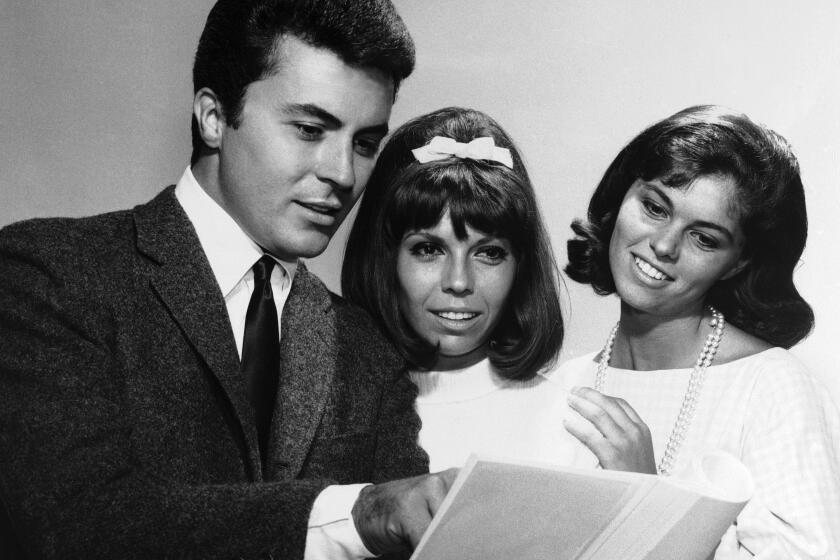In Hollywood Movies, It’s the Year of the Boy : Films: Studio executives cite ‘Home Alone’ and the fact that most of them are late-blooming baby boomers as reasons for more family fare hitting the screen.
When “Free Willy,” the story of a young boy who tries to save a whale from captivity, opened recently, it became the 10th movie this year--the fourth so far this summer--whose plot description begins with the phrase, “The story of a young boy who . . . “
A sampling:
* “Rookie of the Year” is the story of a young boy who develops a miraculous fastball and becomes a major league pitcher.
* “Dennis the Menace” is the story of a young boy who drives his crotchety old neighbor crazy.
* “Jack the Bear” is the story of a young boy who tries to make a man of his father.
* “Last Action Hero” and “Sidekicks” are both stories of young boys who get to team up with their favorite action stars.
* “Last Action Hero” also shares its plot with “Cop and a Half,” the story of a young boy who helps a veteran cop smash the mob.
Yes, it is the monsoon season for boys-at-the-helm movies and it’s far from over. Between now and the end of the year, at least 10 more “young boy who . . .” movies will flood theaters. Among them: “King of the Hill,” “Searching for Bobby Fischer,” “Man Without a Face,” “Father Hood,” “Josh & S.A.M.,” “A Perfect World” and two others, “The Good Son” and “The Nutcracker,” starring the young boy who started it all, Macaulay Culkin.
When Culkin smashed through with “Home Alone” 2 1/2 years ago, he won quick comparisons with Shirley Temple, the most dominating child star in history, and by the time “Home Alone” hit the $200-million mark in box-office grosses, the race was on to find another Culkin, another “Home Alone,” another bonanza.
Not since “Star Wars” launched a thousand spaceships has a single movie turned Hollywood as quickly as “Home Alone.” Where “Star Wars” convinced the studios that special-effects movies aimed at teen-agers was the way to go, “Home Alone” persuaded them to go after the family audience with stories about kids.
In 1990, there were only two major American movies with kids as their central characters, the delightfully witty “Home Alone” and a sour film called “Problem Child.” In ‘91, there were four, including the rushed sequel to “Problem Child,” and last year, there were four more, led by the blockbuster “Home Alone 2.”
It takes a while for Hollywood to gear up to repeat itself--two years from now, this story will be about how “Sleepless in Seattle” changed everything--but the occasion is finally at hand.
*
Studio executives acknowledge the impact of “Home Alone,” but also attribute the boom in family fare to the fact that most of them are late-blooming baby boomers with families of their own, and that they tend to respond to stories with which they can identify.
Fair enough. Since most of those executives are men, reading scripts written mostly by men, that may also explain why so few of these child-driven pictures are about “young girls who . . . “
Among the nearly two-dozen kid movies being released this year, only two--”Life With Mikey” and the upcoming “My Secret Garden”--have girls as their central characters. And the one big hit movie starring a girl, the 1991 “My Girl,” was largely marketed on the strength of Culkin’s supporting role as star Anna Chlumsky’s ill-fated buddy.
The male orientation of this rash of kids’ movies comes as no surprise to those who have noticed the ongoing lack of roles for women. The gender imbalance has been consistent in Hollywood since the almost simultaneous collapse of the old studio system and the advent of television more than 40 years ago.
Until the early 1950s, Hollywood provided America with the bulk of its family entertainment, and it developed its own pool of stars--romantic leads, children, dogs, talking mules--to serve us. The studios spent a lot of money grooming children, and those who caught on with the public paid huge dividends. The child stars, with their relatively short career spans, would be rushed through a dozen or so movies before age or overexposure used them up.
The household names of the ‘30s, ‘40s and ‘50s included Shirley Temple, Jackie Coogan, Jackie Cooper, Dickie Moore, Mickey Rooney, Deanna Durbin, Judy Garland, Roddy McDowall, Margaret O’Brien, Peggy Ann Garner, Natalie Wood, Brandon de Wilde and Hayley Mills.
Their modern parallels are not found in movies, but in TV series. By the mid-’50s, television had completely co-opted the family entertainment business and, in the process, developed something similar to the studio contract system. With TV series designed to run for years, the producers made it their job to discover and develop child stars, and to hold on to them with run-of-the-series contracts. Thus, household names, at least while they were working, were Jay North, Jerry Mathers, Melissa Gilbert, Ron Howard, Gary Coleman and Valerie Bertinelli.
*
Meanwhile, the movie companies concentrated on creating entertainment that television couldn’t provide--movies about youthful rebellion, drug use, infidelity.
For the last two decades, in particular, the studios have nurtured projects they think they can market with broad national campaigns aimed at the teen-age boys and adult men who they believe form the bulk of the moviegoing audience. That meant more action, more adventure, more violence, more profanity, more sexual explicitness.
The studios had relied on those elements for so long, and with enough success, to count as aberrations such family hits as “E.T.” and “Honey, I Shrunk the Kids,” and were taken completely by surprise by the stampede to “Home Alone.”
The question the studios may expect to have answered this year is whether the “Home Alone” movies succeeded because families, fed up with the randy content of TV and movies, were itching for a few wholesome laughs. Or, because Culkin is the genuine item, a charismatic child star.
If all the 1993 kid movies don’t do well as a group, if they don’t produce a couple more child stars, the studios will likely conclude that “Home Alone” was a fluke. That Culkin is an exotic bird with about two years of flight left in him, and the bidding for his services (the kid is already pulling down Schwarzeneggerian fees) will continue to escalate.
So far, the boomlet has been something of a bust. “Last Action Hero,” the most expensive and most hyped film of the year, is a major disappointment.
“Dennis the Menace,” made by the John Hughes organization with the same recipe used to cook up “Home Alone,” has done just modest box-office business. “The Adventures of Huck Finn” and “Cop and a Half” did OK, but don’t look for the sequels.
Not all of the movies that fit the “young boy who” description are “Home Alone” wanna-bes, and comparisons will be unfair.
Steven Soderbergh’s “King of the Hill,” which opens in August, is a serious drama based on author A.E. Hotchner’s experiences as a young boy during the Depression.
“Man Without a Face,” which will mark Mel Gibson’s debut as a director, is the story of a floundering boy who is rescued intellectually by the deformed man he befriends.
“This Boy’s Life,” which opened to good reviews and lukewarm business earlier this year, was based on an autobiographical account of an abused boy growing up in the ‘50s.
Still, as different as they are, it’s unlikely that all of these pictures would have been green-lighted if the studios hadn’t been pre-sold on the idea of a strong adolescent lead.
How audiences respond to the year’s crop of kids’ movies shouldn’t be taken as a referendum on anything. The family audience is out there, as always, waiting to be surprised, entertained and illuminated. If they reject these, it won’t be because there were too many with kids in them, but because too many of them were the same.
More to Read
Only good movies
Get the Indie Focus newsletter, Mark Olsen's weekly guide to the world of cinema.
You may occasionally receive promotional content from the Los Angeles Times.










